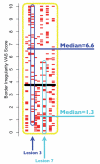Novice identification of melanoma: not quite as straightforward as the ABCDs
- PMID: 21311845
- PMCID: PMC3325479
- DOI: 10.2340/00015555-1070
Novice identification of melanoma: not quite as straightforward as the ABCDs
Abstract
The "ABCD" mnemonic to assist non-experts' diagnosis of melanoma is widely promoted; however, there are good reasons to be sceptical about public education strategies based on analytical, rule-based approaches--such as ABCD (i.e. Asymmetry, Border Irregularity, Colour Uniformity and Diameter). Evidence suggests that accurate diagnosis of skin lesions is achieved predominately through non-analytical pattern recognition (via training examples) and not by rule-based algorithms. If the ABCD are to function as a useful public education tool they must be used reliably by untrained novices, with low inter-observer and intra-diagnosis variation, but with maximal inter-diagnosis differences. The three subjective properties (the ABCs of the ABCD) were investigated experimentally: 33 laypersons scored 40 randomly selected lesions (10 lesions × 4 diagnoses: benign naevi, dysplastic naevi, melanomas, seborrhoeic keratoses) for the three properties on visual analogue scales. The results (n = 3,960) suggest that novices cannot use the ABCs reliably to discern benign from malignant lesions.
Figures




References
-
- Rigel DS, Russak J, Friedman R. The evolution of melanoma diagnosis: 25 years beyond the ABCDs. CA Cancer J Clin. 2010;60:301–316. - PubMed
-
- Friedman RJ, Rigel DS, Kopf AW. Early detection of malignant melanoma: the role of physician examination and self-examination of the skin. CA Cancer J Clin. 1985;35:130–151. - PubMed
-
- American Academy of Dermatology ABCDs of melanoma detection. 2010 [cited 2010 Nov 15]. Available from: http://www.aad.org/public/exams/abcde.html.
-
- British Association of Dermatologists Sun awareness - mole checking. 2010 [cited 2010 Nov15]. Available from: http://www.bad.org.uk/site/719/default.aspx.
-
- Australasian College of Dermatologists A-Z of skin-moles & melanoma. 2010 [cited 2010 Nov 15]. Available from: http://www.dermcoll.asn.au/public/a-z_of_skin-moles_melanoma.asp.
Publication types
MeSH terms
Grants and funding
LinkOut - more resources
Full Text Sources
Medical

